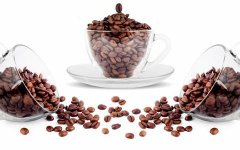Processing method of high-quality coffee beans coffee refining method

There are a pair of oval seeds in the center of the fruit of the coffee tree, which are covered with exocarp, endocarp and pulp. Ripe fruit will rot in a short period of time without treatment, so the purpose of refining is to enable coffee beans to be preserved for a long time, easy to store and circulate.

Figure (1) Coffee fruit
After the fresh coffee fruit is harvested, it should be dealt with immediately. Refining is to remove the skin and pulp of the coffee fruit, and then remove the seed from the shell, which is what we often call raw coffee beans. The refined coffee beans are still raw beans, and then they are roasted to produce the various flavors of coffee beans that we usually drink.
1. Coffee refining method
Coffee refining methods are mainly divided into three categories: drying method, water washing method and semi-washing method. Generally speaking, the coffee fruit of 5000KG can be obtained from 1000kg coffee raw beans.
1.1 drying method
Drying is a traditional processing method of coffee beans, the fruits need to be dried in the natural sun after harvest, and some mechanical drying is carried out at the same time. The process is: harvest → sun field (sunlight exposure) → sheller (remove pulp, etc.) → grading (electronic bean selector or hand selection, screen, etc.) → export.

Figure (2) Coffee beans dried
The color of raw beans treated by drying is yellow, and the water content of coffee beans is generally about 11%, 12%. The advantage is that sun beans have better sweetness and mellow thickness, and less sour taste, so many coffee fans like it very much. The disadvantage is that due to the use of artificial and natural treatment methods in the process, the sun-cured beans do not look good in appearance, do not look good, the quality is unstable, and there will be greater ups and downs.

Figure (3) Coffee beans dried
1.2 washing method
Water washing is the most popular treatment method at present, and most boutique coffee beans will choose water washing method. Washing coffee refining process: harvest → storage tank (removal of impurities and immature beans) → pulp removal machine (removal of pulp and impurities) → fermentation tank (removal of mucous membrane attached to endocarp) → washing pool (selection of light and hard beans) → sun drying field (or dryer) → sheller (removal of endocarp) → grading (electronic bean selector or hand selection, sieve, etc.) → outlet.

Figure (4) washing drying field
The appearance of coffee beans processed by washing is neat, and the impurities and defective beans are less, and the water content of coffee beans is generally about 16%. The advantage is that it has less miscellaneous flavor, clear taste and bright sour taste; the biggest disadvantage is that coffee beans are easy to get sour and astringent taste during fermentation, and a fermented bean will spoil 50 grams of beans.

Figure (5) Yega Xuefen G2 / Water washing method
1.3 semi-washing method
Semi-washing, also known as "honey treatment", is a compromise between drying and washing, eliminating the need to ferment coffee fruits. Harvest → storage tank (remove impurities and immature beans) → pulp removal machine (remove pulp and impurities) → washing pool (select light and hard beans) → sun field (or dryer) → sheller (removal of endocarp) → classification (electronic bean selector or hand selection, sieve, etc.) → outlet.

Figure (6) Coffee fruit after removing the pulp
The quality of honey treatment is more stable than that of drying treatment, but not as good as that of washing treatment. This method of processing coffee beans by honey treatment has recently been sought after by coffee lovers. It has a sweet taste and is rich in Crema. It is suitable for extracting Espresso from the base of Italian coffee. The advantage is that it can restore the flavor of coffee beans, the coffee is more sweet, and the taste of red wine is outstanding. The disadvantage is that coffee beans are very vulnerable to contamination and mildew during the drying process after the exocarp of coffee berries are removed.
Important Notice :
前街咖啡 FrontStreet Coffee has moved to new addredd:
FrontStreet Coffee Address: 315,Donghua East Road,GuangZhou
Tel:020 38364473
- Prev

Common coffee beans are classified according to their sense of taste. Sweet and sour coffee flavor.
Sour taste: mocha, Hawaiian sour coffee, Mexico, Guatemala, Costa Rica high real estate, Gillimanjaro, Colombia, Zimbabwe, El Salvador, Western Hemisphere washable high-grade new beans. Bitter: all kinds of old beans from Java, Mantenin, Bogota, Angola, Congo, Uganda. Sweetness: Colombian Maitenin, Venezuelan old beans, Blue Mountain, Kyrgyzstan
- Next

Common sense of Coffee the characteristics and uses of Robusta coffee beans
"Robusta" coffee, commonly known as "sturdy beans", can be grown at low elevations (200 to 800 meters above sea level), has strong resistance to diseases and insect pests, is not vulnerable to agricultural disasters, has a high annual output per unit area, and is harvested in large quantities by machine. in general, the cost of production is much lower than that of Arabica coffee. "Robusta" coffee usually has an ordinary, rigid and pungent flavor, and because
Related
- Guji coffee producing area of Guji, Ethiopia: Humbela, Shakiso, Wulaga
- What is the most expensive variety of Qiloso in BOP multi-variety group?
- How to store the coffee beans bought home?
- Why are Yemeni coffee beans so rare now?
- Ethiopian Sidamo all Red Fruit Sun Sun Santa Vini Coffee beans
- SOE is mostly sour? What does it mean? Is it a single bean? what's the difference between it and Italian blending?
- Is Italian coffee beans suitable for making hand-brewed coffee?
- How to choose coffee beans when making cold coffee? What kind of coffee beans are suitable for making cold coffee?
- Just entered the pit to make coffee, what kind of coffee beans should be chosen?
- Can only Japan buy real Blue Mountain Coffee? What are authentic Jamaican Blue Mountain coffee beans?

